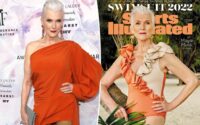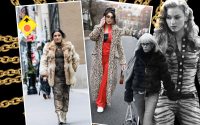Who is Karl Lagerfeld? Iconic moments, controversies, more
Karl Lagerfeld hated fashion exhibitions.
“Fashion does not belong in a museum,” he once told Andrew Bolton, the curator of the Costume Institute at the Metropolitan Museum of Art. “It belongs in the street — on the backs of living women, not motionless mannequins.”
“I have no interest in the past,” he added. “I’m only interested in the present and what the future holds.”
And yet, just four years after his death at 85, the Costume Institute is giving him his own museum show — and a Lagerfeld-themed Met Gala in his honor.
“I’m at peace with the small role I’ve played in this last contradiction because I know he would have loved being recognized,” Anna Wintour wrote in the latest Met Gala-themed issue of Vogue. “And there’s simply no one more deserving.”
Bolton, at the press preview for the exhibit on Monday, acknowledged that while Lagerfeld “never changed his opinion” regarding fashion exhibitions, “he also never declined any of our requests to include his work in any of our exhibitions.”
“Karl Lagerfeld: A Line of Beauty,” which runs from May 5 to July 16, celebrates the famed German designer’s contributions to fashion.

It includes 150 garments, along with sketches, from his 65-year career spanning his work at Chloé, Fendi and — most significantly — Chanel, as well as his own namesake label. (There are even a couple H&M ensembles from his collaboration with the mass-market retailer and items from his own wardrobe, including his signature leather gloves and starched shirt.)
On Monday, an elite group of partygoers said to include everyone from Kim Kardashian to Florence Pugh, will join hosts Penelope Cruz, Dua Lipa, Michaela Coel and Roger Federer — and, of course, Wintour — for the Met Gala, all dressed “in honor of Karl.”
“I often imagine him leaning over us from above, perhaps even mocking us for honoring his life’s work in a museum,” said former supermodel Carla Bruni at the preview Monday. “Something we all knew he would scoff at!”
Lagerfeld was revered in the fashion industry, both because of his work — injecting moribund brands like Chanel with youthful energy and verve — and because of his larger-than-life persona: the powdered ponytail, the sunglasses and chains, the bitchy bon mots and catty comments.

But he was also beset by controversy toward the end of his life, frequently offering his opinions about everything from fat people to the #MeToo movement and Syrian refugees — and offending just about everyone in the process.
Bolton, in the exhibition’s catalog, wrote that the Costume Institute wanted to focus on “Lagerfeld the designer — his works, not his words.”
Yet some fashion fans said you can’t separate the art from the artist. After all, they said, Lagerfeld mined his own image and celebrity for publicity, and certainly his designs, creating mink keychains in his likeness for Fendi, for example.
“I don’t think that’s like a very honest analysis of Karl,” said Chloe Iris Kennedy, one of the founders of the virtual High Fashion Twitter Met Gala, which hosts thousands of participants.
“It’s not something that can be fragmented. It’s not, like, oh, all of this happened and then at the very, very end he was problematic. It’s woven into his legacy.”
Lagerfeld’s fashion legacy

“When I was younger I wanted to be a caricaturist,” Lagerfeld said. “In the end I’ve become a caricature.”
Lagerfeld was born Sept. 10, 1933, in Hamburg, Germany, the son of a prosperous businessman and his chic, but severe wife. He was not like most boys in the provincial capital.
Little Karl loved sketching and hated sports — he avoided anything that could damage his hands and thus endanger his drawing. He favored suits and bow ties.
According to the recent biography “Paradise Now: The Extraordinary Life of Karl Lagerfeld,” by William Middleton, when Lagerfeld was 4, he asked his parents for his own valet.
“I wanted my clothes prepared so I could wear anything I wanted at any time of the day,” Lagerfeld explained, adding that he often changed his outfit four times in 24 hours.
His mother Elisabeth could be cruel — allegedly tying 8-year-old Karl to his bed so he wouldn’t get up to eat in the middle of the night. But she was accepting of her son’s homosexuality and encouraged his interests.
That led him to Paris, where he studied fashion illustration. In 1954, when he was 21, he won the prestigious Woolmark Prize for a sketch he did for a coat, setting off his career and eventually landing him a job at couture house Balmain. (There’s a reproduction of that coat in the Met’s show.)
But Lagerfeld got bored at Balmain and then Patou, another storied French label.
“He was a couturier at a traditional couture house — but he felt that by the early ’60s, that wasn’t where the excitement was,” Middleton told The Post. “So he left to go on his own, and it really started the whole idea of a freelance designer.”

Soon brands started calling Lagerfeld to add some vitality and verve to their offerings.
He joined the youthful Parisian label Chloé in 1964, where he let his imagination run wild with witty collections inspired by Deco, Surrealism and Art Nouveau.
Fendi — mainly known for its furs and bags — hired him a year later to turn the house into a high-fashion brand. For his first collection, “The Abominable Snow Woman,” he combined mink, chinchilla and fox furs in shades of apricot and gray to create floor-length coatdresses, swinging minis and even a jumpsuit.
He stayed at Fendi 54 years, producing endless riffs on fur: dipping it in 22-karat gold, shaping it into Elizabeth ruffs and puffed sleeves, using it for sporty bomber jackets.
“I think that really was like his specialty — taking house codes, and reinterpreting them a million different ways and never getting bored,” stylist and writer Mosha Lundström Halbert told The Post. “He never got bored of using fur or using the Fendi F logo, which he designed.”
“It was the same of Chanel,” she added. “He never got bored of tweed, the camellias, the chains, the pearls. He was continually approaching a rather limited set of parameters but with limitless creative expression.”
His larger-than-life persona

By the time Lagerfeld went to Chanel in 1983, he was already a controversial figure in the fashion industry, known for his hard-partying coterie. He once let his boyfriend, louche aristocrat Jacques de Bascher, plan a Chloé event that devolved into an S&M orgy.
His feuds with frenemy Yves Saint Laurent, the ruthlessness with which he cut people out of his life (which he would later do with Vogue’s Andre Leon Talley) and his eccentric get-ups (from his tight monokinis during his bodybuilding days, to his powdered ponytail and monocles later on) began to creep into the headlines.
He also enjoyed shocking the press.
When asked how he would approach designing for such a classically French brand, he said, “Chanel is an institution, and you have to treat an institution like a whore — then you get something out of her.”
He shortened Chanel’s frumpy tweed skirt suits and loaded them up with gold chains. He put ripped jeans on the runway and bikini tops emblazoned with the double-C logo. He pulled from hip-hop and the high street (his Spring 1996 collection was inspired by the Gap, Lundström Halbert noted), and from Renaissance art and the court of Versailles. The top models walked his shows: Naomi Campbell, Claudia Schiffer, Kate Moss, Devon Aoki.

“He was really the first person to show how you could take a grand old house like that, and make it young and modern and exciting,” said Middleton. “It went from practically bankrupt to an $11 billion company [by the time of his death].”
Chanel got so big under “Kaiser Karl” that the German designer began to overshadow founder Coco herself.
In 2001, he became famous for shedding 92 pounds so he could fit into the new slim Dior Homme suits, and ended up publishing a diet book about it.
He partnered with H&M — the first high-fashion designer to do so — and was featured in the brand’s ads and T-shirts like a celebrity. He designed a bottle for Diet Coke, his favorite beverage.
His shows for Chanel got absurdly lavish: the Fall 2010 show featured a 265-ton, 30-foot iceberg imported from Sweden; Fall 2017 ended with a Chanel-branded rocketship taking flight. His cat, Choupette, had two maids. As his own brand, Karl Lagerfeld, failed to gain real traction, some wondered if he actually had his own point of view. (Pulitzer Prize-winning critic Robin Givhan proclaimed him “overrated.”)
His controversial statements

Wintour was right: Lagerfeld loved being recognized, and he often courted controversy to get it.
“I think the public persona could be interpreted by some people as being harsh,” said Middleton. He called singer Adele “a little too fat,” and blamed fat people for France’s social security woes.
He told Numero Magazine in 2018 that he was “fed up” with the #MeToo movement, which had encouraged women to come forward about their experiences being abused by powerful men, including fashion photographer Patrick Demarchelier, adding, “If you don’t want your pants pulled about, don’t become a model! Join a nunnery.”
In 2017, he gave an interview on French TV criticizing chancellor Angela Merkel’s decision to let in refugees from Syria into Germany.
“One cannot — even if there are decades between them — kill millions of Jews so you can bring millions of their worst enemies in their place,” he said. He cited an anecdote in support of his assumptions that Jewish people and refugees are at odds.
He added: “I know someone in Germany who took a young Syrian and after four days said, ‘The greatest thing Germany invented was the Holocaust.’ ”

“I don’t think any of us are ignorant to the fact that Karl Lagerfeld was a very important person in fashion,” said Kennedy, who added that there will be no High Fashion Twitter Met Gala this year for the first time since it launched in 2020. (“Our values don’t align with the selection of Karl Lagerfeld of the theme,” the group announced online.)
“But I don’t think [he merits] fanfare or celebration, especially on something that has such a large stage as the Met Gala. We fall under every single identity that Karl Lagerfeld has ever insulted,” she added.
And yet, for better or worse, he did change the way fashion works.
“Lagerfeld really created the blueprint of how to modernize a moribund French label,” fashion historian Bronwyn Cosgrave said.
“And everyone followed him — Bernard Arnault at Louis Vuitton, Francois Pinault at Gucci. … Those points of view [against him] are valid, but in terms of his stature and what he has done to modernize the fashion industry, there really isn’t an equal.”


